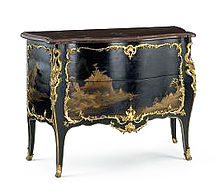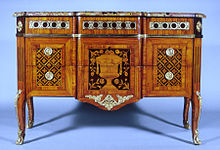| Revision as of 21:38, 4 October 2014 editNataraja87 (talk | contribs)222 editsm →History and types: spelling← Previous edit | Revision as of 17:51, 10 February 2015 edit undoSilenceBow (talk | contribs)93 edits Dating maintenance tag: {{refimprove}}Next edit → | ||
| Line 1: | Line 1: | ||
| {{refimprove|date= |
{{refimprove|date=February 2015}} | ||
| ] and japanned, by ], Paris, c. 1750-60 ]<ref>V&A Museum no. 1094-1882</ref>]] | ] and japanned, by ], Paris, c. 1750-60 ]<ref>V&A Museum no. 1094-1882</ref>]] | ||
| ] commode of mid-1770s, showing vestiges of the ] in the stiffened ]s and softened transitions between planes (])]] | ] commode of mid-1770s, showing vestiges of the ] in the stiffened ]s and softened transitions between planes (])]] | ||
Revision as of 17:51, 10 February 2015
| This article needs additional citations for verification. Please help improve this article by adding citations to reliable sources. Unsourced material may be challenged and removed. Find sources: "Commode" – news · newspapers · books · scholar · JSTOR (February 2015) (Learn how and when to remove this message) |


A commode, commode with legs, or commode on legs is any of several pieces of furniture. The word commode comes from the French word for "convenient" or "suitable", which in turn comes from the Latin adjective commodus, with similar meanings.
History and types
Originally, in French furniture, a commode introduced about 1700 meant a low cabinet, or chest of drawers at the height of the dado rail (à hauteur d'appui). A commode, made by an ébéniste (cabinet-maker) and applied with gilt-bronze mounts, was a piece of veneered case furniture much wider than it was high, raised on high or low legs and with (commode à vantaux) or without enclosing drawers. The piece of furniture would be provided with a marble slab top selected to match the marble of the chimneypiece. A commode occupied a prominent position in the room for which it was intended: it stood against the pier between the windows, in which case it would often be surmounted by a mirror glass, or a pair of identical commodes would flank the chimneypiece or occupy the center of each end wall. Bombé commodes, with surfaces shaped in three dimensions were a feature of the rococo style called "Louis Quinze". Rectilinear neoclassical, or "Louis Seize" commodes might have such deep drawers or doors that the feet were en toupie—in the tapering turned shape of a child's spinning top. Both rococo and neoclassical commodes might have cabinets flanking the main section, in which case such a piece was a commode à encoignures; pairs of encoignures or corner-cabinets might also be designed to complement a commode and stand in the flanking corners of a room. If a commode had open shelves flanking the main section it was a commode à l'anglaise
Before the mid-eighteenth century the commode had become such a necessary commodity that it might be made in menuiserie, of solid painted oak, or walnut or fruitwoods, with carved decoration, typical of French provincial furniture.
In the English-speaking world, commode passed into London cabinet-makers' parlance by the mid-eighteenth century, to describe chests of drawers with gracefully curved fronts, and sometimes with shaped sides as well, perceived as being in the "French" taste. Thomas Chippendale employed the term "French Commode Tables" to describe designs in The Cabinet-Maker and Upholsterer's Director (1753), and Ince and Mayhew illustrated a "Commode Chest of drawers", plate xliii, in their Universal System of Household Furniture, 1759–62. John Gloag notes that Commode expanded to describe any piece of furniture with a serpentine front, such as a dressing table, or even a chair seat. Gloag points out that Thomas Shearer's designs for two "commode dressing chests" illustrated in The Cabinet-Makers' London Book of Prices, 1788, plate 17, are repeated, but as "serpentine dressing chests", in The Prices of Cabinet Work, 1797 edition.
Toilet

The term "commode" is also a colloquial synonym used for a flush toilet in some areas of the United States.
In the United Kingdom, the term "commode" is very frequently used for a chair, often on wheels, enclosing a chamber pot—as such it is used in hospitals and the homes of those with incontinence or limited mobility.
See also
Notes
- V&A Museum no. 1094-1882
- A commode with a divided drawer above two deep ones was a commode en tombeau— a "monumental commode"— or, in retrospect, a commode à la Régence.
- The slab might be veneered with a fine or rare marble, such as a breccia; its edges might be moulded.
- Such a piece, when made particularly shallow, not to impede passage along the enfilade that connected rooms might be called a demi-commode (Francis J. B. Watson, Louis XVI Furniture 1973, fig.fig. 27).
- "In a room with three windows, for instance, one could place between them a commode with drawers and one with drawers, while still preserving an essential symmetry." (Pierre Verlet, French Furniture and Interior Decoration of the 18th Century, 1967) p. 154)
- Francis J. B. Watson, Louis XVI Furniture 1973, illustrates as commodes à encoignures the commode by Gilles Joubert and Roger Vandercruse La Croix, 1769 for Mme Victoire at Compiègne (fig. 23 (Frick Collection, New York); the commode by Joubert for Mme Adelaide at Versailles, 1769 (fig. 24, Getty Museum, Los Angeles); the unusually rich and monumental commode by Jean-Henri Riesener for the king's bedroom at Versailles, 1775 (fig. 32, Musée Condé, Chantilly).
- Gloag, A Short Dictionary of Furniture , rev. ed. 1969, s.v. "Commode, "Commode Front".
- Richard Magrath, a cabinet-maker and upholsterer in Charleston, South Carolina, advertised for sale in 1771 ""Half a Dozen Caned Chairs, a Couch to match them, with commode fronts, and Pincushion seats." (Noted in Gloag, op. cit, s.v. "Commode Front").
- "Cambridge Dictionaries online, entry for Commode". Retrieved 20 January 2013.